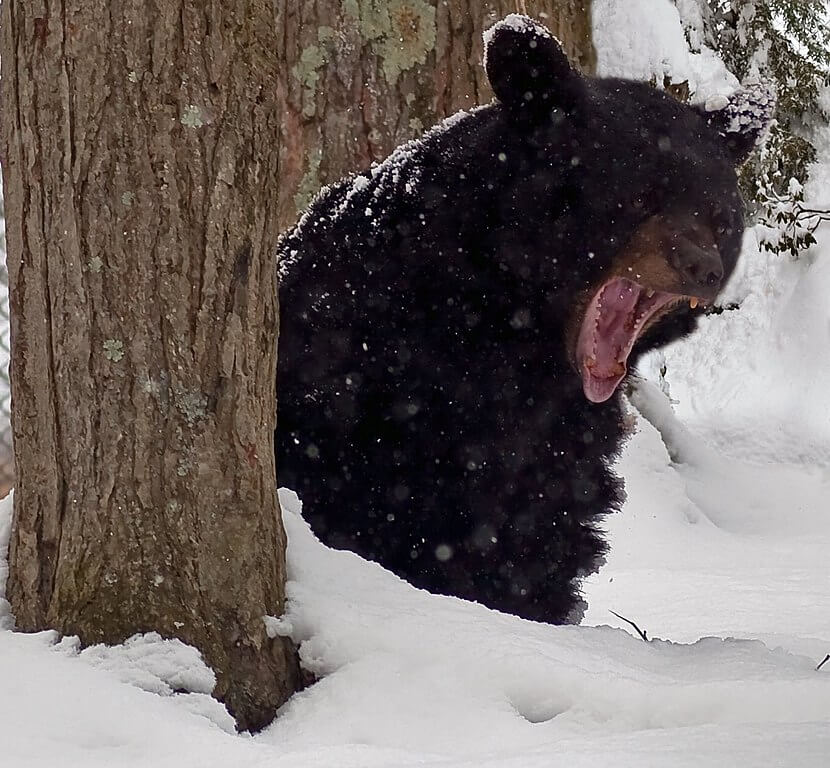Bears and Birdfeeders
By Ed Monnig
Broadcast 4.2013, 5.2018, 3.29 & 4.1.2023

Black bears typically emerge from their dens around the first week of May, but some may do so earlier. Photo courtesy of forestwander.com, CC by-SA 3.0.
Listen:
My wife Jackie and I live on the edge of the city. We share our lot with wildlife whose space we have intruded. Deer fertilize our lawns. They congregate here as a refuge from predators and other hunters. But in the bargain they trade for new dangers. They have not fully adapted to automobiles at speed. And some become a food source in turn for magpies, ravens, and eagles.
Mountain lions and coyotes are attracted to the plentiful food source of our suburban Serengeti. These predators are rewarded with the occasional pet when the deer prove too elusive.
I pondered my role in this system as I restocked our bird feeder recently. My bird feeder is a new food source for the system. An ecologist would say I am adding primary productivity to the first trophic level in the ecosystem. The bird species that are herbivores and thus part of the second trophic level of this food chain benefit from my largess. Unfortunately bears, which are both herbivores and carnivores, are attracted to this food source. Since humans are somewhat leery of the carnivorous side of a bear’s personality, attracting bears to human environments is problematic, especially for the bear.
So every spring, we heed the advice that a “fed bear is a dead bear” and we dismantle our bird feeders. And in the fall we restock our bird feeders on the assumption that a hibernating bear will not raid our feeders in the winter season
However, that begs the question. When exactly do bears begin and end hibernation? Last year we had a very mild mid-fall season in western Montana. Do milder temperatures and low snow accumulations affect the bear’s decision to begin and end hibernation?
I posed these questions to Jamie Jonkel, our local bear specialist with Fish Wildlife and Parks. According to Jamie, bears are guided more by the length of daylight hours than by a delay in the onset of winter weather.
Most bears in western Montana settle into their winter dens around the first week of November. However, there are exceptions to this rule. Larger male bears may stay out longer.
Likewise bears that have not put on enough weight for winter hibernation or who are injured may stay out longer as they try to fatten up. Jamie has seen such bears wandering around as late as mid-January.
Most bears reemerge from their winter dens around the first week of May. Again there are exceptions. Male bears may emerge earlier.
For these reasons Fish Wildlife & Parks recommends that those of us who live in or near bear country limit bird feeders to December 1st through April 1st. Because bears are wide-ranging, most of us who live outside the core area of our towns are in bear country.
Wild species make this a special place, and our living among them brings responsibilities. We share our lot with wildlife; our place and fate are intertwined.
Every week since 1991, Field Notes has inquired about Montana’s natural history. Field Notes are written by naturalists, students, and listeners about the puzzle-tree bark, eagle talons, woolly aphids, and giant puffballs of Western, Central and Southwestern Montana and aired weekly on Montana Public Radio.
Click here to read and listen to more Field Notes. Field Notes is available as a podcast! Subscribe on Apple Podcasts or wherever you listen to podcasts.
Interested in writing a Field Note? Contact Allison De Jong, Field Notes editor, at adejong [at] montananaturalist [dot] org or 406.327.0405.
Want to learn more about our programs as well as fun natural history facts and seasonal phenology? Sign up for our e-newsletter! You can also become a member and get discounts on our programs as well as free reciprocal admission to 300+ science centers in North America!












